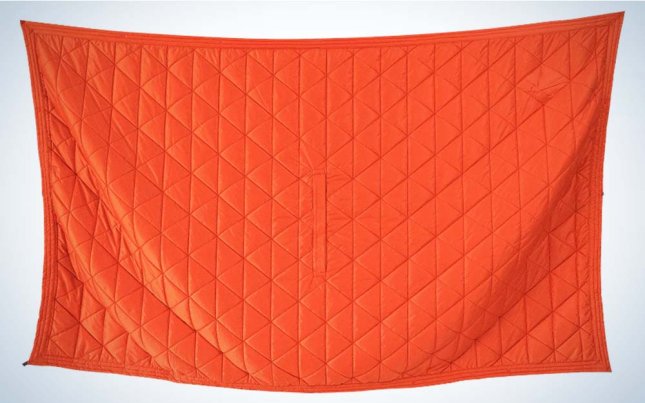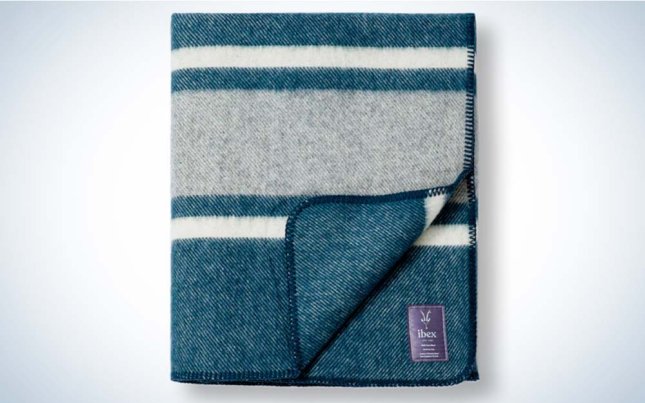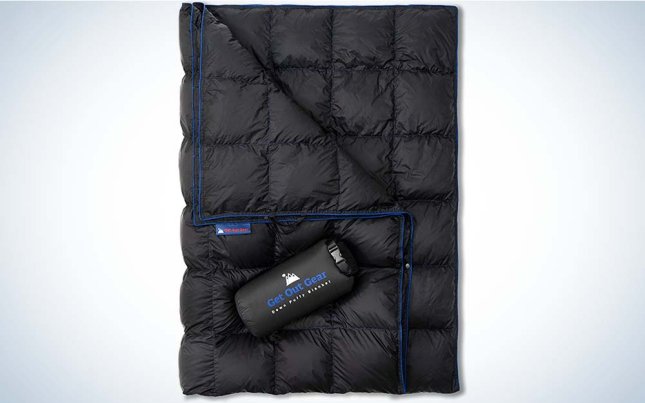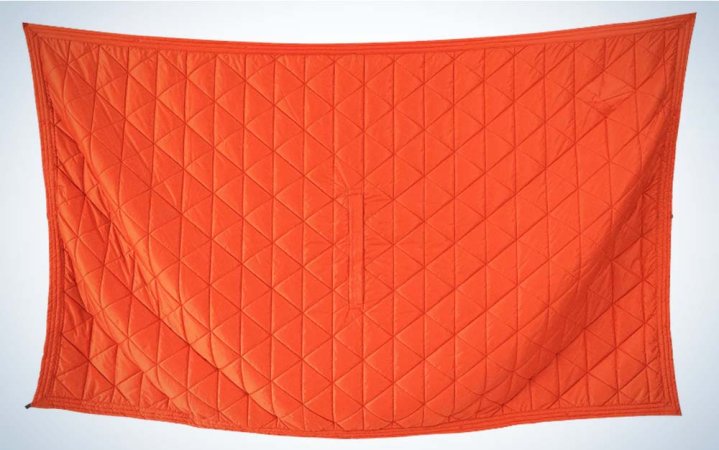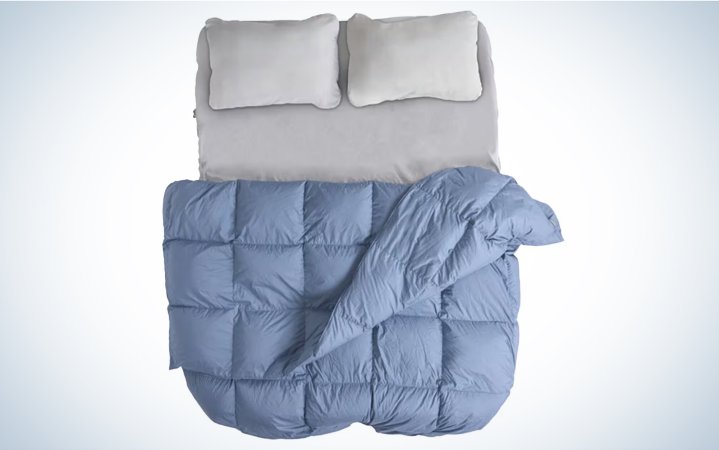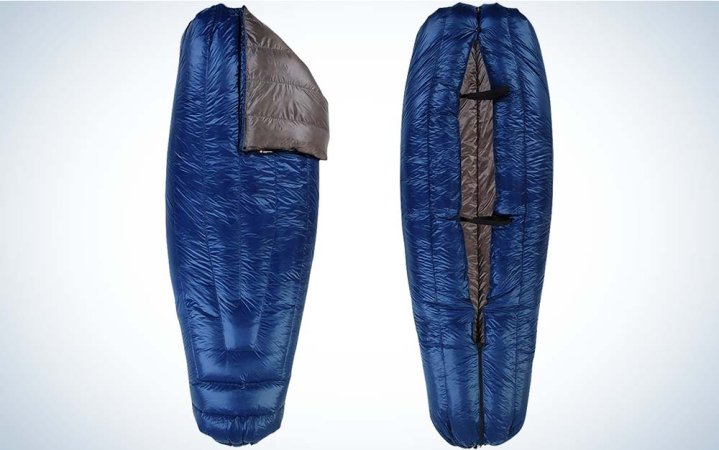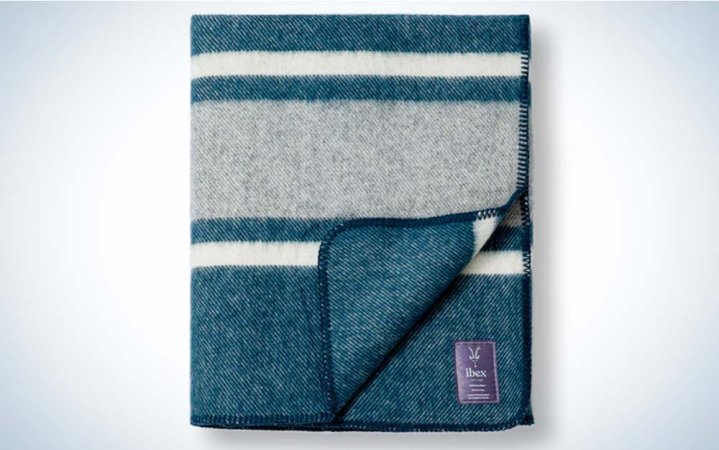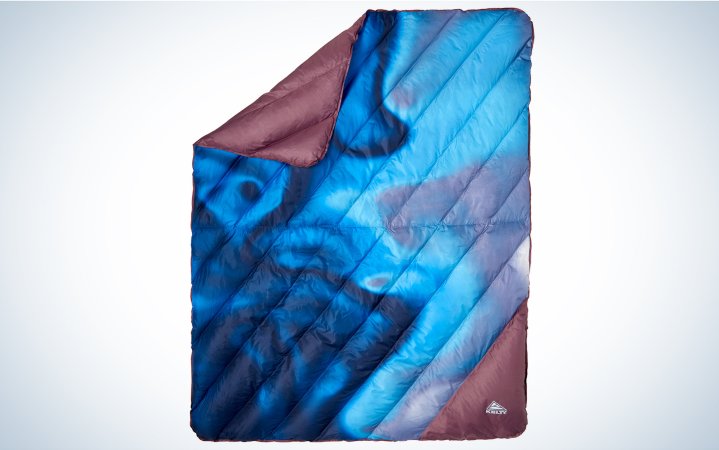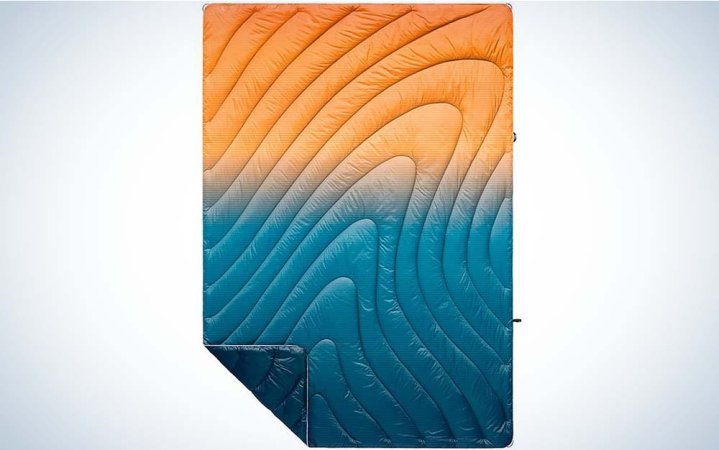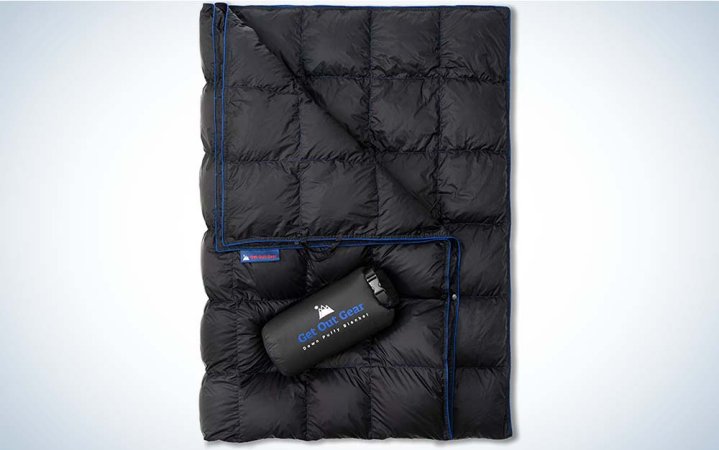We may earn revenue from the products available on this page and participate in affiliate programs. Learn More ›
If you are looking to coax a loved one or friend into the outdoors with you, it might be time to add a camping blanket to your arsenal. While not a traditional camp standby, it has the power to turn a chilly morning, a too-thin sleeping bag, or impromptu stargazing into something comfortable and downright cozy. To find the best camping blankets to elevate your home base setup, I took 12 of the top options available today and narrowed it down to seven of the best.
- Best Overall: Kammok Mountain Blanket
- Best for Sleeping: HEST Down Comforter
- Best Customization: Enlightened Equipment Revelation Quilt
- Best Wool: Ibex Wool Blanket
- Best Down: Kelty Galactic Down Blanket
- Best Eco-Friendly: Rumpl Original Puffy
- Best Budget: Get Out Gear Down Camping Blanket
- Best All-Terrain: YETI Lowlands Blanket
How I Tested the Best Camping Blankets
My testing for camping blankets varied depending on each product’s intended purpose. Synthetic- and down-filled camping blankets (and one poncho), including the Klymit Versa, Thermarest Argo and Honcho Poncho, Get Out Gear Down Camping Blanket, iKamper RTT Blanket DPL, and Rumpl Original Puffy, were evaluated for warmth (by sitting out on a wet-cold spring morning where temps hovered in the mid forties without my puffer jacket), packability, and water resistance. Wool blankets, from Ibex and Filson/Pendleton, were evaluated for skin feel and flexibility, to see whether it would function as well as a blanket to wrap yourself in as to lay on the ground or over in your knees in the traditional style. For the two picnic blankets in my test, the Dometic GO Camp Blanket and YETI Lowlands Blanket, I evaluated water resistance on the underside, ease of cleaning on the top side, as well as flexibility and heft. The Kammok Mountain Blanket, which was in a class of its own, was tested on a number of the above metrics.
I’ve continued to test the best camping blankets (adding some new options into the mix) over numerous camping and backpacking trips, including looking a wide range of quilts as part of OL‘s test of the best backpacking quilts.
The Best Camping Blankets: Reviews & Recommendations
Best Overall: Kammok Mountain Blanket
Pros
- As warm as any camping blanket we tested
- Versatile
- Stuff sack can be used as a pillow
Cons
- Less water resistant than others in my test (I wouldn’t use this on anything wetter than a light morning dew)
- Bulky
Key Features
- Size: 84 x 50 inches
- Packed size: 15.5 inches x 9.5 inches x 9.5 inches
- Materials: 40D nylon ripstop shell and polyester
- Machine washable
I was fully expecting one of the puffer blankets—filled with light-as-air down feathers or state-of-the-art synthetic fill—to claim the top spot. But in the end, it was a fleece blanket that impressed me most. Not just any fleece blanket, though: a fleece blanket lined with an impressively hardy 40D nylon ripstop fabric on one side that I had no hesitation throwing on the ground. One with a wide snap-button opening in the center that you can poke your head into, poncho style. And that fleece? I grew up in the PNW, so I know fleece, and this is some quality fleece. But it wasn’t until I was stuffing this one away after testing that I finally noticed the detail that won my heart. The stuff sack is lined on the inside with fleece. I immediately saw myself turning that sack inside out and stuffing it with my puffer jacket and a spare shirt. Who needs to bring a pillow? The space savings pays for itself.
Surprisingly — even with its comparatively small amount of puffer insulation—this provided as much warmth as any camping blanket I tested. That being said, I would not advise using this as an alternative to a true sleeping bag unless you are confident that nighttime temperatures won’t dip below 60 degrees. Beyond wishing that there was just a tad more insulation with this camping blanket (a common theme in my test), I also found that the stitching on the nylon side, some of which seemed more for decoration than baffling, allowed more water to seep into the blanket than others.
Best for Sleeping: HEST Down Comforter
Pros
- Very comfortable
- Warm enough for even cold sleepers
Cons
- Expensive
Key Features
- Size: 88 x 58 inches (single), 88 x 80 inches (double)
- Packed size: 8 x 12 inches (single), 9 x 14 inches (double)
- Materials: 40D polyester
- Machine washable
Personally, I don’t like sleeping bags much. Not only are they are annoying to get into and out of, they are also pretty claustrophobic. But for decades, they were all that was on offer if you wanted to sleep out of doors.

So I was excited to test out the Hest Down Comforter, which is a down blanket built for sleeping out of doors. It boasts almost two pounds of 650 fill power down for the double version and, unusually, in nearly a year of using it I have yet to see any down plumes poke through the 40D outer fabric. Even better, this one has a great, comfortable skin feel in addition to being dirt and water resistant. I initially tested it while camping in the fall in the Pacific Northwest, and came away so impressed with its warmth and comfort that I started using it at home. While I sleep warm, I’m confident that even cold sleepers will find the Hest Down Comforter more than adequate during the cool nights of the summer months.
Best Customization: Enlightened Equipment Revelation Down Quilt
Pros
- Customizable size and temperature ratings down to 0 degrees
- Great skin feel
- Can be closed up or spread out flat
Cons
- Not especially durable
- Pricey
- Technically not a camping blanket
Key Features
- Size: customizable (four different lengths and three different widths)
- Packed size: customizable
- Materials: 7D to 10D nylon and 850fp down, 950fp down, or synthetic fill
- Machine washable
Before the Hest Down Comforter arrived on the scene, the vast majority of camping blankets barely provided enough warmth to throw over your legs on a typical summer night, when temperatures struggle to dip to the fifties. While you could use them to add a smidge of extra warmth to your sleeping bag setup, they were not appropriate to use on their own, even for the warmest sleepers. Fortunately, you could always snag one of the best backpacking quilts if you were trying to get away from the strait-jacket feel of a sleeping bag.
I’ve used the Enlightened Equipment Revelation in all manner of conditions, from late summer snow to early spring rains to backpacking at over 10,000 feet in Colorado, and it’s been one of the best sleeping bags for that purpose. I chose a 20-degree bag, which keeps me warm to about freezing in reality, but you can also choose temperature ratings as low as 0 degrees. In fact, the only time it wasn’t the best choice to use was when nighttime temperatures got stuck in the upper 70s in late July in Northern California. Then I might have preferred a camping blanket.
Another upside to Enlightened Equipment is that offer a healthy degree of customization, with four different lengths, three different widths, and six different temperature ratings.
Best Wool Blanket: Ibex Wool Blanket
Pros
- Soft to the touch
- Warm
- Large enough for two people to sit under
- Can be used on the ground in the right conditions
Cons
- Dry clean only
- Expensive
Key Features
- Size: 76 inches x 56.5 inches
- Packed size: 20 inches x 18 inches x 6 inches
- Materials: wool
- Dry clean only
If you have a reluctant camper you’re working on converting, this may well be one of the best camping blankets for you. Not only is it super cozy and perfect for throwing over your legs around the campfire or layering over your sleeping bag for a bit of extra warmth at night, but it also just looks great, so it has a touch of glamp that will elevate just about any setup.
Wool has a reputation for being scratchy, and there is a reason for that: wool fibers have natural scales on them, but this Ibex blanket bucked that trend with excellent skin feel. Unless you have a wool allergy, you’ll find this blanket comfortable.
While this blanket is plenty durable for ground use, I’m not recommending it for that purpose, especially since it’s expensive to buy and clean.
Best Down: Kelty Galactic Down Blanket
Pros
- Affordable
- Contains 550 fill power down
- Perfect layer for hot summer nights
Cons
- Fabric skin feel is less comfortable than others I’ve tested
Key Features
- Size: 72 inches x 55 inches
- Packed size: 7 inches x 12 inches
- Materials: 50D polyester with 550fp duck down
- Machine washable
There aren’t many camping blankets that use down fill instead of synthetic, so I was stoked to check out the Kelty Galactic Down Blanket. While it looks a lot like the synthetic options I’ve tested in the past, my family noticed that it delivered noticeably more warmth (and more quickly) than its synthetic counterparts. It was warm enough that my three-year-old even opted to sleep underneath it for part of the when temperatures were on the high side.
While the vibrant colors of the Kelty Galactic make this camping blanket a joy to look at, the actual skin feel leaves something to be desired. After camping with it for 10 days in the humidity of Washington State’s Olympic Peninsula it started to feel tacky to the touch, compared to the more silky skin feel of the Enlightened Equipment quilt or the fleecy Kammok Mountain Blanket. But assuming you toss it in the wash on a regular basis, the price point on this down-filled option is hard to beat.
Best Eco-Friendly: Rumpl Original Puffy
Pros
- Incorporates 60 recycled bottles per blanket
- Reasonable price
- Super water resistant
- Small packed size
Cons
- Ran colder than many of the camping blankets in my test
Key Features
- Size: 75 inches x 52 inches
- Two-person size available
- Packed size: 16 inches x 7 inches
- Materials: 30D polyester ripstop shell and polyester filled
- Machine washable
Let’s start with the elephant in the room: this just isn’t a very warm blanket. If you need a 10 degree boost, this might get the job done (assuming you don’t run cold), but if you’re looking for some real insulation, you’d be better off with one of the other picks on this list.
OK, now that we’ve got that out of the way, let’s move on to what’s to love here. First off, the shell and insulation is 100 percent recycled polyester, the only product in my test to incorporate recycled materials. Next there’s the 30D ripstop shell, which was easily the most water resistant fabric in the test (plus, it comes in a huge number of fabulous colors). Finally, its low profile and low price (although neither were as low as my best budget pick) make it a good option for anyone with a more minimalist setup.
Best Budget: Get Out Gear Down Camping Blanket
Pros
- Low price
- Smallest packed size in my test
- Warm enough to use on its own during summer months
- Nylon exterior had a great skin feel
Cons
- Small footprint
- Less water resistant than other camping blankets
Key Features
- Size: 77 inches x 50 inches (I measured at 73 inches x 50 inches)
- Packed size: 12 inches x 5 inches
- Materials: 20D nylon ripstop shell
- Machine washable
Down is still considered the gold-standard in insulation compared to synthetic alternatives and this camping blanket shows why. Whereas my arms were still chilly with bulkier synthetic options, the Get Out Gear Down Camping Blanket blocked the chill from my arms surprisingly fast, and by the end of my 15-minute testing period was downright cozy. I would feel comfortable sleeping under this one so long as temps didn’t drop below fifty-five degrees, but that’s only because I’m on the shorter side. While the manufacturer states that this one is 77-inches long, I measured it at 73 inches (I also confirmed the 50-inch width measurement).
The nylon shell, while smooth and soft against my skin, also proved less water resistant than other options. Keep this one in the tent if a drizzle looks imminent. Still, for the price and quality this budget-friendly blanket makes a great addition to your setup.

Unfortunately, during ongoing testing with this item durability problems have started to arise. Specifically, the snap buttons can tear the fabric when you pull them apart, revealing the down innards of the camping blanket.
Best All-Terrain: YETI Lowlands Blanket
Pros
- Waterproof bottom
- Cloth fabric on top cleans easily
- Its heft and weight won’t blow around in the wind
Cons
- Expensive
Key Features
- Size: 78 inches x 55 inches
- Packed size: 20 inches x 9 inches x 8 inches
- Materials: polyester and rayon
- Machine washable
Color me skeptical when I first took out the YETI Lowlands Blanket — a picnic blanket? At that price? Can’t I just use a ten dollar tarp? But after taking this camping blanket along on a three-day spring camping trip that saw everything from sleet to twenty-five mile per hour gusts, consider me a convert.
The first thing I noticed was this blanket’s heft. We threw it down to put our toddler onto while we set up the tent, but even as the wind blew the poles and nylon out of our hands, the Lowlands didn’t move at all. Then we just left it on the ground for the rest of our trip, haphazardly walking over it to retrieve supplies out of the back of our SUV, lugging it closer to the fire to sit on, or watching it turn into an imaginary boat for the toddler’s stuffed animals. On the last day, sleet and freezing rain meant we were motivated to pack things up in a hurry, and we simply tossed the Lowlands on top of the rest of our gear before heading out to find some hot coffee (that didn’t come from our camping percolator). But when we got home, all the dirt and debris that had been on the blanket just sort of fell off. No mud, no residue. We didn’t even have to wash it. With that, the Lowlands made its way into my permanent rotation.

Note that this is not a blanket to throw on top of your sleeping bag for extra warmth; if that is what you are looking for, check out some of the other options on this list.
Things to Consider Before Buying a Camping Blanket

Purpose
We often ask camping blankets to pull double-duty, to protect us from the wet and mud on the ground while having lunch midday and then also keep us warm as twilight sets in the evening. And while some blankets are both tough and warm, typically durability and comfort don’t go hand in hand. Before purchasing a camping blanket, consider what you’re most likely to use it for.
Materials
Camping blankets can be made out of a range of different materials: from fleece, to wool, to down, to synthetics. While the latter two are often seen as standalones, they differ in how well they function in different conditions, and the type of care they need. Fleece, which tends to be cheaper, has a moderate warmth-to-weight ratio, and can repel some water before becoming saturated (and losing much of its ability to insulate). Wool, on the other hand, is an excellent insulator, and continues to provide a great deal of warmth even when wet. It also does a better job blocking wind than other materials. It is, however, more expensive than other materials, and it requires specialized care, such as dry cleaning.
Down is easily the best insulator out of any of these and provides more warmth for weight than just about any other material used in outdoor gear. If you look at a down feather, you’ll see that it’s made up of innumerable wisps connected to a short shaft. The lack of structure to these feathers creates small air pockets, which trap heat from your body and insulate it from the cold outside air. Down-feather quality is measured by fill power (fp), or how much down it takes to fill one cubic inch of space. For instance, one ounce of 550fp down will fill about 9 liters, while one ounce of 900fp will fill almost 15 liters. The Achilles heel of down feathers has always been moisture—when down gets wet, the pockets of air disappear, eliminating virtually all of its insulating properties. In recent years, manufacturers have started using down feathers treated with a water-resistant coating, sometimes referred to as DownTek, but there are several different names. With down products, it’s also worth looking to whether the product is RDS (Responsible Down Standard) certified, which helps ensure that no geese or ducks were unnecessarily harmed (such as live plucking).
The sleeping bags of slumber parties are a good example of synthetic fill. With high-end synthetic fill mimicking the qualities of down, these use short filaments that create pockets to trap your body heat. Further, synthetic fill retains heat while wet without the need for additional treatment. The highest quality synthetic fills can approach the insulation-to-weight ratio of 550fp down, but these synthetics also approach the cost of lower quality down.
Down and synthetics are typically encased by either polyester or nylon of varying thicknesses, which is measured in denier (D). Most camping blankets use fabrics between 20D and 50D. And nylon is generally a stronger material than polyester.
Size
There are two sizes to take into consideration—the square footage the blanket covers when spread out and its packed size. The former measurement will help you determine whether a blanket is best used for a single person or a couple, keeping your legs warm on cold mornings, or sleeping under it on warm nights. The latter, however, is important if you have limited space, especially if you’re planning to take your camping blanket out on a backpacking trip.
FAQs
Camping blankets can cost anywhere from $70 to upwards of $250, depending on their materials.
Camping blankets are considered an “extra” for most people looking to spend a night in the outdoors. While some of the camping blankets I tested for this story leaned into that—pulling out all the stops to create a unique product that could serve several purposes or employing high-quality materials to create a comfortable experience that bordered on luxurious—that wasn’t true for everything. In this category, making a thoughtful decision about what you purchase can have a major impact on your satisfaction with that purchase.
In the outdoors, the better substitute for a sleeping bag is a camping quilt, which is a distinct product category. While camping blankets are typically meant as an extra layer to keep you warm around the campfire, camping quilts are designed, like sleeping bags, to keep you warm all the way down to the freezing nighttime temperatures.

Final Thoughts on the Best Camping Blankets
While there are a number of prominent gear manufacturers making camping blankets, including Klymit, Thermarest, Kammok, YETI, Ibex, Dometic, Filson/Pendelton, iKamper, Get out Gear, and Rumpl, the quality and value of these products varies considerably. In general, I was disappointed with the quality of the synthetic blankets that I tested—ultimately neither the iKamper RTT, Klymit Versa, nor the Thermarest Honcho Poncho or Argo were warm to include in this roundup (although the latter came close). But after testing and comparing the different camping blankets on the market to one another, I feel confident that both Get Out Gear and Kammok make some of the best camping blankets on the market. Similarly, the weight and flexibility of the YETI Lowlands, though more expensive, ultimately made it the better option over the Dometic GO Camp Blanket, and the softness of the Ibex blanket made it my preferred choice over the comparatively scratchy Mackinaw Wool Blanket.
- Best Overall: Kammok Mountain Blanket
- Best for Sleeping: HEST Down Comforter
- Best Customization: Enlightened Equipment Revelation Quilt
- Best Wool: Ibex Wool Blanket
- Best Down: Kelty Galactic Down Blanket
- Best Eco-Friendly: Rumpl Original Puffy
- Best Budget: Get Out Gear Down Camping Blanket
- Best All-Terrain: YETI Lowlands Blanket

